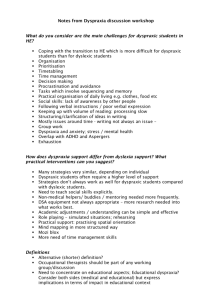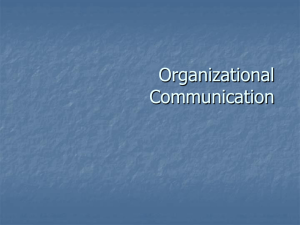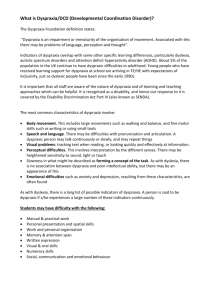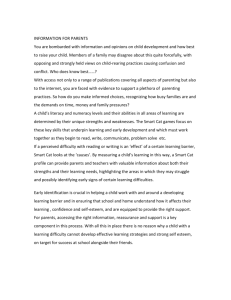ADSHE Guidelines for Trainers
advertisement
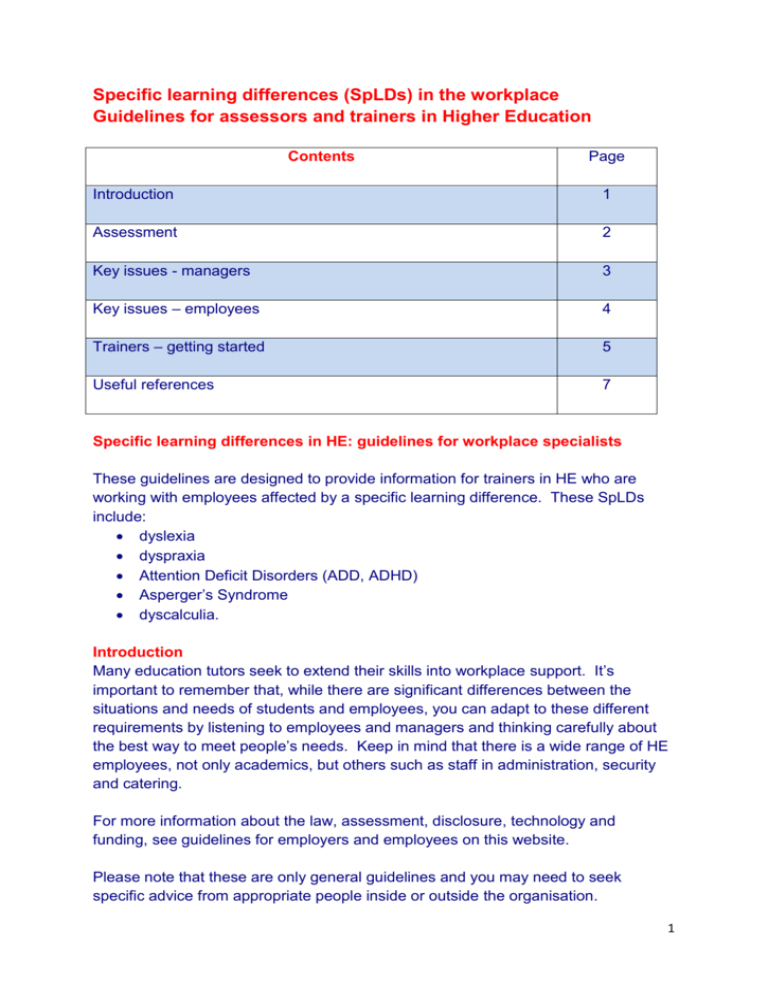
Specific learning differences (SpLDs) in the workplace Guidelines for assessors and trainers in Higher Education Contents Page Introduction 1 Assessment 2 Key issues - managers 3 Key issues – employees 4 Trainers – getting started 5 Useful references 7 Specific learning differences in HE: guidelines for workplace specialists These guidelines are designed to provide information for trainers in HE who are working with employees affected by a specific learning difference. These SpLDs include: dyslexia dyspraxia Attention Deficit Disorders (ADD, ADHD) Asperger’s Syndrome dyscalculia. Introduction Many education tutors seek to extend their skills into workplace support. It’s important to remember that, while there are significant differences between the situations and needs of students and employees, you can adapt to these different requirements by listening to employees and managers and thinking carefully about the best way to meet people’s needs. Keep in mind that there is a wide range of HE employees, not only academics, but others such as staff in administration, security and catering. For more information about the law, assessment, disclosure, technology and funding, see guidelines for employers and employees on this website. Please note that these are only general guidelines and you may need to seek specific advice from appropriate people inside or outside the organisation. 1 Assessment The basic principles of identifying dyslexia and/or dyspraxia remain the same, whether your assessee is a student or an employee. It’s wise to follow the assessment guidelines used for the Disabled Student Allowance. Here are some further points to keep in mind when carrying out workplace assessments: Prioritise the workplace situation when planning the assessment and analysing the individual’s pattern of strengths and difficulties, e.g. you may need to include in your report an assessment of numeracy, speaking and listening skills, and/or memory and organisation. Literacy may (or may not) be as important as in student assessments. There may be other job-specific areas you need to discuss, e.g. ability to read maps, remember detailed instructions, take witness statements, work in a busy open-plan office or perform complex physical tasks. Be mindful of present and future report requirements, e.g. some employers may not accept examination recommendations without an assessment of general cognitive ability, or the individual may be aiming for career progression in the same or another field. Think carefully about the report’s audience, which may include managers or Human Resources advisers, perhaps some years ahead, and include a clear summary, explanations of your terms and the reasons for difficulties, explaining the nature of the SpLD. Avoid jargon or ambiguous terminology. Always discuss strengths and positive ways that difficulties can be managed. It’s important to show how a support package aims to improve the individual’s ability to carry out the job, e.g. by increasing efficiency or lessening stress. It’s useful to have the summary, conclusions and recommendations on separate pages, so an individual can easily copy these to others as necessary, without giving the full report. Be cautious about including any information which may be misinterpreted, e.g. stating that an individual is mildly affected by dyslexia may mean a manager fails to understand why a particular task is extremely difficult for an employee to achieve. Avoid including information which an employee may not wish to disclose in this way to a present or future employer, e.g. physical or mental illness. See reference list on page 7 for more detail on workplace assessments. 2 Key issues – managers If managers are not involved in the assessment or support process from the start, it is important to try and include them at the earliest possible stage. It’s vital for the assessor/trainer to understand managers’ attitudes to, and evaluation of, the employee, so that you can work with this, to encourage, support, explain, provide information and advice, and perhaps counteract misunderstandings. Support should be tailored not only to the employee’s priorities, but also to the needs of the workplace, usually via the manager. You may need to tactfully remind an employer of their legal responsibilities. Some employers may be positive and supportive, some may be bewildered and seeking clear advice, some may prefer to ignore you, while others may be overtly hostile, or perhaps seeking a way to dismiss or sideline the employee. Whatever the situation is, your role will be most useful if you can convey understanding of all viewpoints, keep communication channels open and retain a clear idea of your professional responsibilities and boundaries. Managers may have little knowledge or understanding of the effects of ordinary working practices on SpLDs, e.g. office noise, time pressures, lastminute demands, interruptions, insistence on following procedures in certain ways. They may not realise the undermining effect of struggling with memory and organisation, or difficulty with apparently “simple” tasks. Managers are understandably concerned with the competence of their staff and getting the job done to time and to a standard. The type of organisation and its culture will play a role too. Your job, therefore, may involve providing information and explanations which will lead to clear, soundly based communications between manager and employee. 3 Key issues – employees Sometimes there may be issues following from workplace restructuring, increased productivity demands, changes to a job description, promotion, a new post or a new manager. These need to be addressed, and the employee supported, to develop effective strategies to manage these changes. Sometimes a key concern is the long hours the employee needs to invest to get the job done. It’s nearly always the case that the employee is concerned with their employer’s and/or their own expectations in relation to accuracy, time and/or quality of work. Employees often want to develop more effective ways of doing their job, involving less time, effort and stress. Organisation and memory are frequently key issues. Specialist training can provide an ideal arena to think about work methods in a calm, supportive environment away from everyday pressures. 4 Workplace trainers – getting started Be prepared – try to get copies of the diagnostic assessment and workplace needs assessment ahead of the first training session. Identify any issues arising and recommendations made. At the first meeting, check that the recommendations from both reports have been, or are planned to be, implemented, if they remain appropriate. Check whether technology training has taken place and how effective it has been – does it need supplementing, applying or practising during the training you will deliver? Be clear on the reasons for referral from both employer’s and employee’s viewpoints. Address these in the training plan. Check that funding is in place and exactly how much has been agreed in writing by a named person in the organisation. Often, funding will be provided through the Access to Work scheme. In this case, note the number of hours, amount of funding agreed and end date; don’t exceed any of these without written permission from AtW. Clients can request additional hours or an extended training period by contacting the AtW officer named in their documentation. You may need to provide a rationale for this to AtW, and support your client in doing this, but reasonable requests are not usually refused. However, be aware of limits on training hours – they are not always as generous as in education. Check what workplace adjustments have been recommended, or discuss what might be useful for your client, e.g. desk location, working in a quiet place or at home, flexible hours, using headphones. Make sure that these are being implemented or there are plans to do so. 5 • Discuss with your client exactly what the job involves, what they feel they do well and what their difficulties are. Note what successful strategies are already in place and the client’s preferred approach. Are there useful strengths on which to build? Are there approaches which are too timeconsuming or stressful? • Then agree a prioritised action plan, starting with something that can make a real difference relatively early – this may often be improving organisation or time management. Aim for noticeable improvement in an area that causes considerable difficulty – even small changes can provide impetus and confidence. • Always work with real tasks and job requirements. Although it’s usually best to use a separate room, you may be able to log on to the client’s computer area there. Or it may sometimes be useful, if the client is happy to do so, for you to sit with them at their desk. • If there are issues of confidentiality in seeing the client’s work, you may need to provide a verbal or written assurance of your professional discretion. • Be flexible and creative in supporting your client to manage their difficulties better – think further than supporting only what individuals do at a desk. Perhaps the workspace could be moved or changed, there could be a new approach to familiar tasks or a specific time for planning each day. • Significant timesavers can include managing filing (paper and electronic) efficiently; making maximum use of electronic calendars, reminders and task lists; dealing with emails effectively (e.g. specific times, deleting, saving attachments, devising an appropriate folder system). Developing routines for these tasks can be extremely useful. • Don’t forget low-tech solutions like post-its, colour-coding, to-do lists, notebooks and desk trays. • When appropriate, don’t neglect to develop strategies for memory, speaking and listening, skills which may be more important to an employee than writing and reading. 6 Some useful references Books & articles Sylvia Moody (ed) (2009) Dyslexia and employment: a guide for assessors, trainers and managers, Wiley Blackwell (includes dyspraxia) Sylvia Moody (2006) Dyslexia: how to survive and succeed at work, Vermilion (includes dyspraxia) Mary Colley (2006) Living with dyspraxia: a guide for adults, Jessica Kingsley Tony Attwood (2008) The Complete guide to Asperger’s syndrome, Jessica Kingsley Russell Barkley (2010) Taking charge of adult ADHD, Guildford Press Ari Tuckman (2009) More attention, less deficit, Speciality Press Anne Henderson (2012) Dyslexia, dyscalculia and mathematics: a practical guide, Routledge (for teachers of children, but there is little available for adults) Katherine Kindersley, Into the workplace: the challenges and opportunities, PATOSS Bulletin, vol 24 no 1, summer 2011 Websites Dyslexia strategies www.dyslexia-adults.com/a15 www.beingdyslexic.co.uk/information/workplace.php www.dyslexiaassessmentandconsultancy.co.uk/about-dyslexia.php Dyspraxia www.dyspraxiafoundation.org.uk Dyscalculia www.dyscalculia.org ADD, ADHD www.addiss.co.uk Asperger syndrome www.autism.org.uk 7



